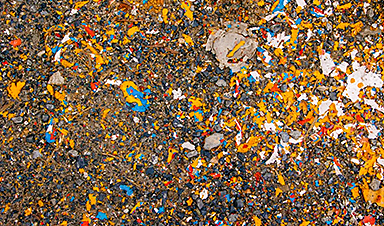Scientists have developed a simple sonication method to create nanoplastics that closely mimic environmental particles, promising more realistic studies of their ecological impact.
Plastics like polyethylene, PET, and polystyrene are used worldwide. Through wear and tear, recycling and chemical disintegration, they eventually break down in nature into tiny fragments. Less than 100 nanometers in size, these nanoparticles are a growing concern as they are being found in organisms and ecosystems.
Scientists are investigating the effect of these plastic nanoparticles in the lab, but most synthetically produced nanoplastics are made using solvents or lots of energy. These chemical processes can create particles that look and behave differently from those formed by natural wear and tear.
The resulting gap between real-world and lab-made particles has made it difficult to study the true risks posed by nanoplastic pollution.
Mimicking Natural Wear And Tear
In the study, published in Nano Express, researchers demonstrate a more natural way to produce nanoplastics. They started with familiar plastic waste (PET bottles, tire wear material, and polystyrene foam) and cryogenically milled them into fine powders to increase surface area and make them more susceptible to fragmentation.
The powders were suspended in ultrapure water inside a temperature-controlled ultrasonic bath. Sonication generated cavitation, which is the rapid formation and collapse of bubbles, causing mechanical stress and breaking the polymers down to the nanoscale.
The team fine-tuned factors such as energy input, sonication duration, and water temperature to avoid melting the polymers or altering their chemical structure. After sonication, they filtered out larger debris through successive glass fibre filters with pore sizes of 10 µm and 1 µm, leaving only the nanoscale particles in suspension.
Testing And Results
The experimental method was completed by different analysts on different days, and results were found to be reproducible. Dynamic light scattering confirmed hydrodynamic diameters centred around 150-300 nm, while nanoparticle tracking analysis measured concentrations near 2×109 particles per millilitre.
Scanning electron microscopy (SEM) revealed a range of heterogeneous particle morphologies, spherical, elongated, and irregular, matching the diversity observed in naturally weathered nanoplastics.
The optimal energy density to produce the desired nanoparticle sizes and shapes was about 7.0 kJ/mL. Lower energy levels yielded incomplete fragmentation, while excessive sonication led to particle agglomeration or deformation.
Some polymers, notably polyethylene, produced fewer nanoparticles, likely because of stabilising additives such as antioxidants and plasticisers impeding their degradation.
Potential For Wider Use
The researchers demonstrated the scalability and straightforwardness of their method. Using only standard lab equipment, it is accessible for all labs studying nanoplastics and their effects on wildlife, water quality, and human health.
By producing particles that better reflect environmental reality, they hope the technique will improve the accuracy of studies on how nanoplastics move through ecosystems and interact with living organisms.
The findings are a significant advance toward establishing standardized testing protocols and improving plastic pollution investigations.
Journal Reference
Adelantado C., et al. (2025). A sonication-assisted method for the production of true-to-life nanoplastics from polymeric materials. Nano Express, 6, 035004. DOI: 10.1088/2632-959X/adeba4, https://iopscience.iop.org/article/10.1088/2632-959X/adeba4
News
Lower doses of immunotherapy for skin cancer give better results, study suggests
According to a new study, lower doses of approved immunotherapy for malignant melanoma can give better results against tumors, while reducing side effects. This is reported by researchers at Karolinska Institutet in the Journal of the National [...]
Researchers highlight five pathways through which microplastics can harm the brain
Microplastics could be fueling neurodegenerative diseases like Alzheimer's and Parkinson's, with a new study highlighting five ways microplastics can trigger inflammation and damage in the brain. More than 57 million people live with dementia, [...]
Tiny Metal Nanodots Obliterate Cancer Cells While Largely Sparing Healthy Tissue
Scientists have developed tiny metal-oxide particles that push cancer cells past their stress limits while sparing healthy tissue. An international team led by RMIT University has developed tiny particles called nanodots, crafted from a metallic compound, [...]
Gold Nanoclusters Could Supercharge Quantum Computers
Researchers found that gold “super atoms” can behave like the atoms in top-tier quantum systems—only far easier to scale. These tiny clusters can be customized at the molecular level, offering a powerful, tunable foundation [...]
A single shot of HPV vaccine may be enough to fight cervical cancer, study finds
WASHINGTON -- A single HPV vaccination appears just as effective as two doses at preventing the viral infection that causes cervical cancer, researchers reported Wednesday. HPV, or human papillomavirus, is very common and spread [...]
New technique overcomes technological barrier in 3D brain imaging
Scientists at the Swiss Light Source SLS have succeeded in mapping a piece of brain tissue in 3D at unprecedented resolution using X-rays, non-destructively. The breakthrough overcomes a long-standing technological barrier that had limited [...]
Scientists Uncover Hidden Blood Pattern in Long COVID
Researchers found persistent microclot and NET structures in Long COVID blood that may explain long-lasting symptoms. Researchers examining Long COVID have identified a structural connection between circulating microclots and neutrophil extracellular traps (NETs). The [...]
This Cellular Trick Helps Cancer Spread, but Could Also Stop It
Groups of normal cbiells can sense far into their surroundings, helping explain cancer cell migration. Understanding this ability could lead to new ways to limit tumor spread. The tale of the princess and the [...]
New mRNA therapy targets drug-resistant pneumonia
Bacteria that multiply on surfaces are a major headache in health care when they gain a foothold on, for example, implants or in catheters. Researchers at Chalmers University of Technology in Sweden have found [...]
Current Heart Health Guidelines Are Failing To Catch a Deadly Genetic Killer
New research reveals that standard screening misses most people with a common inherited cholesterol disorder. A Mayo Clinic study reports that current genetic screening guidelines overlook most people who have familial hypercholesterolemia, an inherited disorder that [...]
Scientists Identify the Evolutionary “Purpose” of Consciousness
Summary: Researchers at Ruhr University Bochum explore why consciousness evolved and why different species developed it in distinct ways. By comparing humans with birds, they show that complex awareness may arise through different neural architectures yet [...]
Novel mRNA therapy curbs antibiotic-resistant infections in preclinical lung models
Researchers at the Icahn School of Medicine at Mount Sinai and collaborators have reported early success with a novel mRNA-based therapy designed to combat antibiotic-resistant bacteria. The findings, published in Nature Biotechnology, show that in [...]
New skin-permeable polymer delivers insulin without needles
A breakthrough zwitterionic polymer slips through the skin’s toughest barriers, carrying insulin deep into tissue and normalizing blood sugar, offering patients a painless alternative to daily injections. A recent study published in the journal Nature examines [...]
Multifunctional Nanogels: A Breakthrough in Antibacterial Strategies
Antibiotic resistance is a growing concern - from human health to crop survival. A new study successfully uses nanogels to target and almost entirely inhibit the bacteria P. Aeruginosa. Recently published in Angewandte Chemie, the study [...]
Nanoflowers rejuvenate old and damaged human cells by replacing their mitochondria
Biomedical researchers at Texas A&M University may have discovered a way to stop or even reverse the decline of cellular energy production—a finding that could have revolutionary effects across medicine. Dr. Akhilesh K. Gaharwar [...]
The Stunning New Push to Protect the Invisible 99% of Life
Scientists worldwide have joined forces to build the first-ever roadmap for conserving Earth’s vast invisible majority—microbes. Their new IUCN Specialist Group reframes conservation by elevating microbial life to the same urgency as plants and [...]























